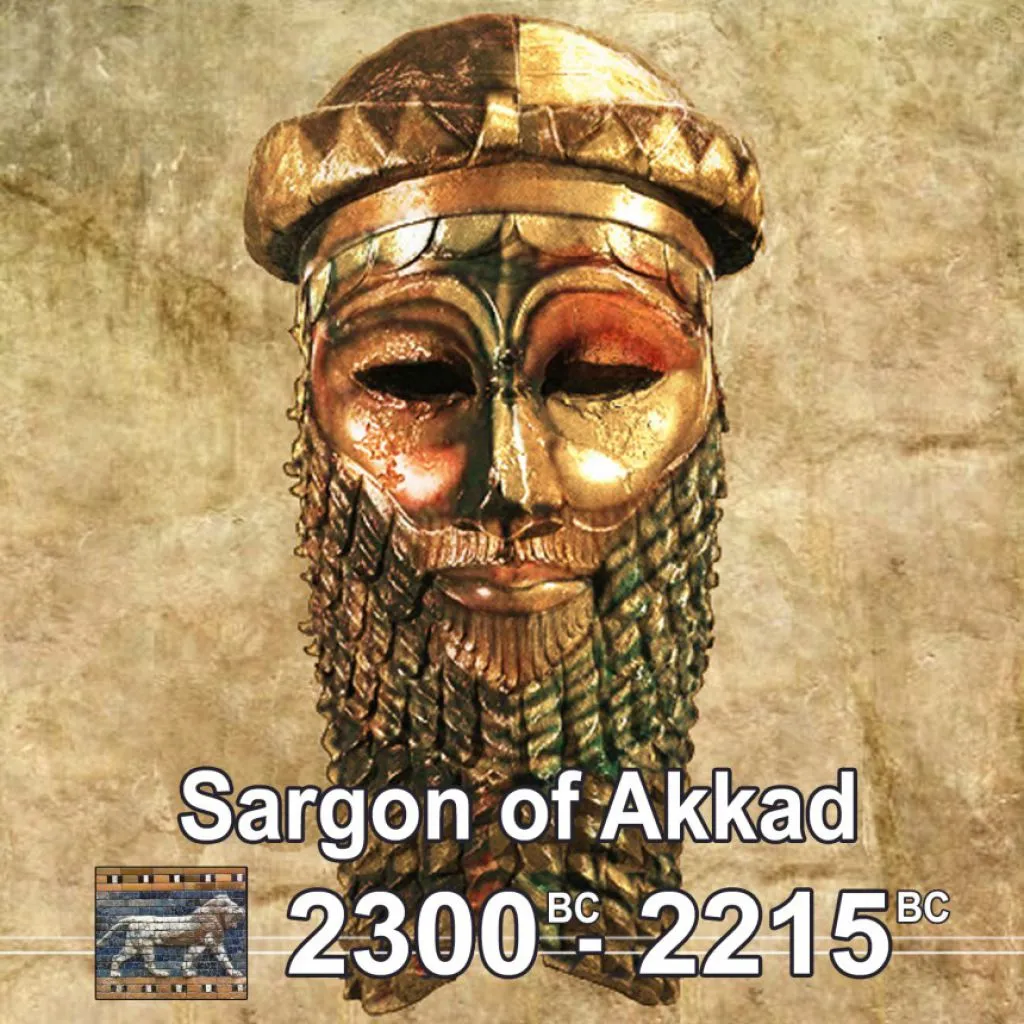
Sargon of Akkad
Sargon of Akkad (Akkadian Šarru-ukīn or Šarru-kēn, also known as Sargon the Great) was the first ruler of the Semitic-speaking Akkadian Empire, known for his conquests of the Sumerian city-states in the 24th to 23rd centuries BC.
He was the founder of the "Sargonic" or "Old Akkadian" dynasty, which ruled for about a century after his death, until the Gutian conquest of Sumer. The Sumerian king list makes him the cup-bearer to king Ur-Zababa of Kish.
His empire is thought to have included most of Mesopotamia, parts of the Levant, besides incursions into Hurrite and Elamite territory, ruling from his (archaeologically as yet unidentified) capital, Akkad (also Agade).
Sargon appears as a legendary figure in Neo-Assyrian literature of the 8th to 7th centuries BC. Tablets with fragments of a Sargon Birth Legend were found in the Library of Ashurbanipal.
The terms "Pre-Sargonic" and "Post-Sargonic" were used in Assyriology based on the chronologies of Nabonidus before the historical existence of Sargon of Akkad was confirmed.
In 1883, the British Museum acquired the "mace-head of Shar-Gani-sharri", a votive gift deposited at the temple of Shamash in Sippar. This "Shar-Gani" was identified with the Sargon of Agade of Assyrian legend.
The identification of "Shar-Gani-sharri" with Sargon was recognised as mistaken in the 1910s. Shar-Gani-sharri (Shar-Kali-Sharri) is in fact Sargon's great-grandson, the successor of Naram-Sin.
CHRONOLOGY
Primary sources pertaining to Sargon are very sparse; the main near-contemporary reference is that in the various versions of the Sumerian king list. Here, Sargon is mentioned as the son of a gardener, former cup-bearer of Ur-Zababa of Kish.
He usurped the kingship from Lugal-zage-si of Uruk and took it to his own city of Akkad. Various copies of the king list give the duration of his reign as either 54, 55 or 56 years.
In absolute years, his reign would correspond to ca. 2340-2284 BC in the Middle Chronology. His successors until the Gutian conquest of Sumer are also known as the "Sargonic Dynasty" and their rule as the "Sargonic Period" of Mesopotamian history.
A newly discovered older version of the king list gives Sargon's reign as lasting for 40 years.
Thorkild Jacobsen marked the clause about Sargon's father being a gardener as a lacuna, indicating his uncertainty about its meaning.
Ur-Zababa and Lugal-zage-si are both listed as kings, but separated by several additional named rulers of Kish, who seem to have been merely governors or vassals under the Akkadian Empire.
The claim that Sargon was the original founder of Akkad has been called into question with the discovery of an inscription mentioning the place and dated to the first year of Enshakushanna, who almost certainly preceded him.
The Weidner Chronicle (ABC 19:51) states that it was Sargon who "built Babylon in front of Akkad."
The Chronicle of Early Kings (ABC 20:18-19) likewise states that late in his reign, Sargon "dug up the soil of the pit of Babylon, and made a counterpart of Babylon next to Agade."
Van de Mieroop suggested that those two chronicles may in fact refer to the much later Assyrian king, Sargon II of the Neo-Assyrian Empire, rather than to Sargon of Akkad.
SOURCES
Among the most important sources for Sargon's reign is a tablet of the Old Babylonian period recovered at Nippur in the University of Pennsylvania expedition in the 1890s.
The tablet is a copy of the inscriptions on the pedestal of a Statue erected by Sargon in the temple of Enlil. Its text was edited by Arno Poebel (1909) and Leon Legrain (1926).
In the inscription, Sargon styles himself "Sargon, king of Akkad, overseer (mashkim) of Inanna, king of Kish, anointed (guda) of Anu, king of the land [Mesopotamia], governor (ensi) of Enlil".
It celebrates the conquest of Uruk and the defeat of Lugalzagesi, whom Sargon brought "in a collar to the gate of Enlil."
Sargon then conquered Ur and E-Ninmar and "laid waste" the territory from Lagash to the sea, and from there went on to conquer and destroy Umma, and he collected tribute from Mari and Elam. He triumphed over 34 cities in total. Ships from Meluhha, Magan and Dilmun rode at anchor in his capital of Akkad.
Submitting himself to the (Levantine god) Dagan, Sargon conquered territories of Upper Mesopotamia and the Levant, including Mari, Yarmuti (Jarmuth?) and Ibla "up to the Cedar Forest (the Amanus) and up to the Silver Mountain (Aladagh?)", ruling from the "upper sea" (Mediterranean) to the "lower sea" (Persian Gulf).
He entertained a court or standing army of 5,400 men who "ate bread daily before him".
QUESTIONS
No one knows where the city of Akkad was located, how it rose to prominence, or how, precisely, it fell; yet once it was the seat of the Akkadian Empire which ruled over a vast expanse of the region of ancient Mesopotamia.
It is known that Akkad (also given as Agade) was a city located along the western bank of the Euphrates River possibly between the cities of Sippar and Kish (or, perhaps, between Mari and Babylon or, even, elsewhere along the Euphrates).
According to legend, it was built by the king Sargon the Great who unified Mesopotamia under the rule of his Akkadian Empire and set the standard for future forms of government in Mesopotamia.
Sargon (or his scribes) claimed that the Akkadian Empire stretched from the Persian Gulf through modern-day Kuwait, Iraq, Jordan, Syria (possibly Lebanon) through the lower part of Asia Minor to the Mediterranean Sea and Cyprus (there is also a claim it stretched as far as Crete in the Aegean).
While the size and scope of the empire based in Akkad is disputed, there is no doubt that Sargon the Great created the first multi-national empire in the world.
SARGON'S RULE
Sargon the Great either founded or restored the city of Akkad. He conquered what he called "the four corners of the universe" and maintained order in his empire through repeated military campaigns.
The stability provided by this empire gave rise to the construction of roads, improved irrigation, a wider sphere of influence in trade, as well as developments in arts and sciences.
The Akkadian Empire created the first postal system where clay tablets inscribed in cuneiform Akkadian script were wrapped in outer clay envelopes marked with the name and address of the recipient and the seal of the sender.
These letters could not be opened except by the person they were intended for because there was no way to open the clay envelope save by breaking it.
In order to maintain his presence throughout his empire, Sargon strategically placed his best and most trusted men in positions of power in the various cities.
The "Citizens of Akkad", as a later Babylonian text calls them, were the governors and administrators in over 65 different cities.
Sargon also cleverly placed his daughter, Enheduanna, as High Priestess of Inanna at Ur and, through her, seems to have able to manipulate religious/cultural affairs from afar.
Enheduanna is recognized today as the world's first writer known by name and, from what is known of her life, she seems to have been a very able and powerful priestess in addition to creating her impressive Hymns to Inanna.























